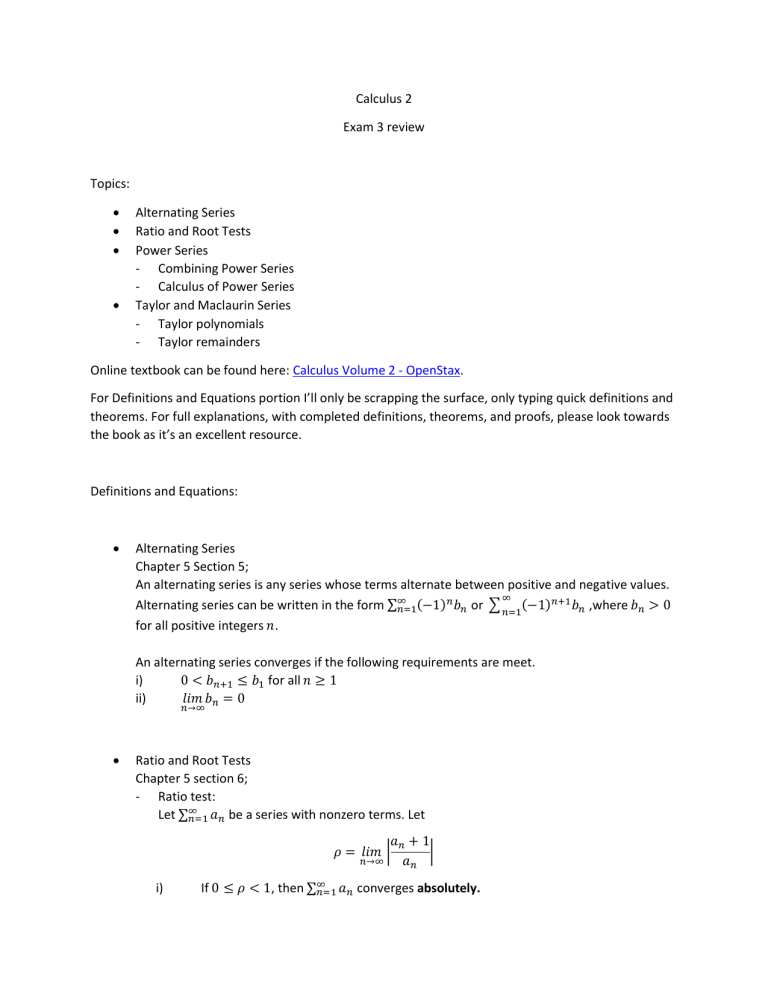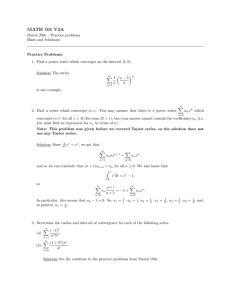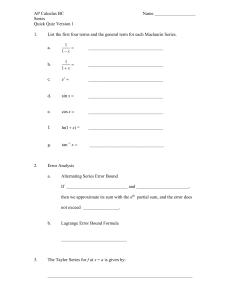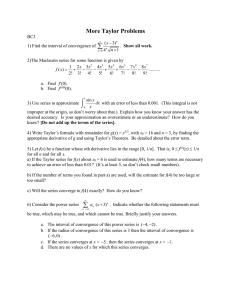
Calculus 2 Exam 3 review Topics: Alternating Series Ratio and Root Tests Power Series - Combining Power Series - Calculus of Power Series Taylor and Maclaurin Series - Taylor polynomials - Taylor remainders Online textbook can be found here: Calculus Volume 2 - OpenStax. For Definitions and Equations portion I’ll only be scrapping the surface, only typing quick definitions and theorems. For full explanations, with completed definitions, theorems, and proofs, please look towards the book as it’s an excellent resource. Definitions and Equations: Alternating Series Chapter 5 Section 5; An alternating series is any series whose terms alternate between positive and negative values. ∞ 𝑛 𝑛+1 Alternating series can be written in the form ∑∞ 𝑏𝑛 ,where 𝑏𝑛 > 0 𝑛=1(−1) 𝑏𝑛 or ∑𝑛=1(−1) for all positive integers 𝑛. An alternating series converges if the following requirements are meet. i) 0 < 𝑏𝑛+1 ≤ 𝑏1 for all 𝑛 ≥ 1 ii) 𝑙𝑖𝑚 𝑏𝑛 = 0 𝑛→∞ Ratio and Root Tests Chapter 5 section 6; - Ratio test: Let ∑∞ 𝑛=1 𝑎𝑛 be a series with nonzero terms. Let 𝜌 = 𝑙𝑖𝑚 | 𝑛→∞ i) 𝑎𝑛 + 1 | 𝑎𝑛 If 0 ≤ 𝜌 < 1, then ∑∞ 𝑛=1 𝑎𝑛 converges absolutely. If 𝜌 > 1 or 𝜌 = ∞, then ∑∞ 𝑛=1 𝑎𝑛 diverges. If 𝜌 = 1, the test does not provide any information ii) iii) - Ratio test: Consider the series ∑∞ 𝑛=1 𝑎𝑛 . Let 𝑛 𝜌 = 𝑙𝑖𝑚 √|𝑎𝑛 | 𝑛→∞ If 0 ≤ 𝜌 < 1, then ∑∞ 𝑛=1 𝑎𝑛 converges absolutely. If 𝜌 > 1 or 𝜌 = ∞, then ∑∞ 𝑛=1 𝑎𝑛 diverges. If 𝜌 = 1, the test does not provide any information i) ii) iii) Note: Absolute and conditional convergence are talked about in detail in 5.5 of the online textbook under checkpoint 5.19. Power Series Chapter 6 sections 1 & 2. Convergence of a Power Series; 𝑛 Consider the power series ∑∞ 𝑛=0 𝑐𝑛 (𝑥 − 𝑎) . The series satisfies exactly one of the following Properties: i) ii) iii) The series converges at x=a and diverges for all x≠a. The series converges for all real numbers x. There exists a real number R > 0 such that the series converges if |x-a| < R and diverges if |x-a| > R. At the values x where |x-a| = R, the series may converge or diverge. Note: Interval of convergence is explained in detail section 6.1 of the openstax textbook with an excellent diagram to help with visualization. 1 The representation of functions as power series revolves around the function 𝑓(𝑥) = 1−𝑥 and its 𝑛 corresponding series, ∑∞ 𝑛=0 𝑥 . This geometric series above (𝑎 + 𝑎𝑟 + 𝑎𝑟 2 + 𝑎𝑟 3 + ⋯) converges if and only if |r|<1. In that 𝑎 1 case, it converges to 1−𝑟. Therefore, if |x| <1, the series converges to 1−𝑥 and we write 1 1 + 𝑥 + 𝑥 2 + 𝑥 3 + ⋯ = 1−𝑥 for |x|<1. 1 As a result, we are able to represent the function 𝑓(𝑥) = 1−𝑥 by the power series 1 + 𝑥 + 𝑥 2 + 𝑥 3 + ⋯ when |x| <1. Taylor Series Chapter 6 section 3 If f has derivatives of all orders at x=a, then the Taylor series for the function f at a is ∞ 𝑓 (𝑛) (𝑎) (𝑥 − 𝑎)𝑛 ∑ 𝑛! 𝑛=0 The nth partial sum of the Taylor series for a function f at a is known as the nth Taylor polynomial. If a=0, then these polynomials are known as Maclaurin polynomials. Taylor’s Theorem with Remainder Let f be a function that can be differentiated n+1 times on the interval I containing the real number a. Let 𝑝𝑛 be the nth Taylor polynomial of f at a and let 𝑅𝑛 (𝑥) = 𝑓(𝑥) − 𝑝𝑛 (𝑥) Be the nth remainder. Then for each x in the interval I, there exists a real number c between a and x such that 𝑅𝑛 (𝑥) = 𝑓(𝑛+1) (𝑐) (𝑥 (𝑛+1)! − 𝑎)𝑛+1 . If there exists a real number M such that |𝑓 (𝑛+1) (𝑥)| ≤ 𝑁 for all 𝑥 ∈ 𝐼 , then |𝑅𝑛 (𝑥)| ≤ 𝑀 (𝑥 (𝑛+1)! − 𝑎)𝑛+1 For all x in I. While I would like to go into more detail about these topics, simply reading about the topics wouldn’t help much. To understand what’s above it’s best to practice. The textbook also has a large pool of questions, so if you feel like you need more practice it’s right there. Alternating Series: 1. State whether the following series converges absolutely, conditionally, or not at all. ∞ ∑(−1)𝑛+1 1 𝑛𝑙𝑛(𝑛) 𝑛=1 2. State whether the following series converges absolutely, conditionally, or not at all. ∞ (−1)𝑛 ∑4 √𝑛8 + 7 𝑛=1 Ratio and Root tests: 1. Prove whether the series converges or diverges. ∞ ∑ 𝑛! 𝑛𝑛 𝑛=1 2. Prove whether the series converges or diverges ∞ ∑ 𝑛=1 𝑛! 𝑛3𝑛 3. Prove whether the series converges or diverges ∞ ∑ 𝑛2𝑛 43𝑛 𝑛=1 4. Prove whether the series converges or diverges ∞ 𝑛 𝑛 ) ∑( 𝑛+1 𝑛=1 2 Power Series: 1. Determine the interval and radius of convergence of the series. ∞ (𝑥 − 3)𝑛 ∑ 𝑛 𝑛=1 2. Determine the interval and radius of convergence of the series. ∞ ∑ 2𝑛 𝑛 2 𝑥 𝑛 𝑛=1 4𝑥 3. Express 2𝑥+3 as a power series. 𝑥2 4. Express (1−2𝑥)2 as a power series. 5. Express 𝑙𝑛(1 − 𝑥) as a power series. Taylor and Maclaurin series: 1. Find the Maclaurin series of 𝑓(𝑥) = 𝑠𝑖𝑛2(𝑥) 2. Find the Taylor series for 𝑓(𝑥) = 𝑥 2 + 2𝑥 + 5 centered at 𝑎 =2 3 3. Approximate 𝑓(𝑥) = √𝑥 using a Taylor polynomial of degree 2 centered at a=8. 3 Use 𝑇2 (𝑥) to approximate √9. 1 4. Let 𝑓(𝑥) = 𝑥 3 , a=1, n=3, 0.8≤x≤1.2 a) Approximate f(x) using 𝑇3 (𝑥) centered at 1. b) Estimate the accuracy of 𝑇3 (𝑥) in the given interval.




